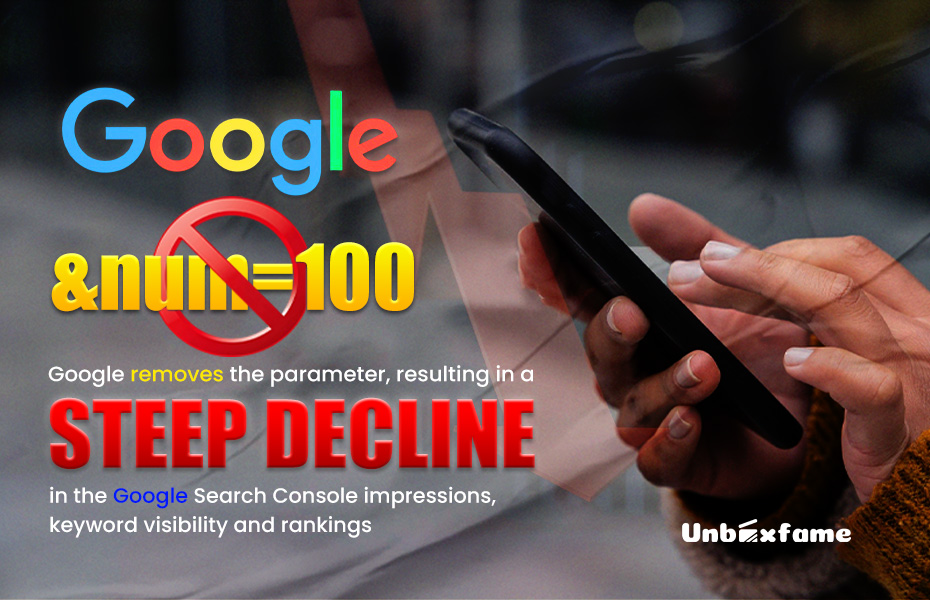Google discontinued the &num=100 parameters a week ago, as it is no longer supported by the tech giant. This parameter has disabled the ability to see 100 search results by using the URL parameter in the Google Search URL bar. The scrapping of the Google num=100 has resulted in sharp drops in Google Search Console impressions, rankings, and keyword visibility.
The Google num=100 update is the latest change made by the tech giant Google, where it no longer supports the num=100 parameter. By removing the &num=100, Google is reshaping the way SEO works. As per the statement of the Google spokesperson, the use of this URL parameter is not something that Google formally supports. 87.7% of sites are witnessing a decline in impressions. Another 77.6% of sites reported lost unique ranking terms. This greatly affected the keyword lengths, with Short-tail and mid-tail keywords taking the biggest hit.
This significant change has disrupted the ranking checking tools, and Google’s own search console data has seen a notable drop in the data. The withdrawal of the &num=100 parameter has brought about changes in the evaluation of performance and keyword visibility. This is changing the way performance is evaluated; even if rankings are constant, reports will appear weaker due to fewer impressions and keywords.
In the past, marketers and SEO experts could use this parameter to show 100 search results on a single page rather than the standard 10. This was helpful in things such as rapidly examining several search results simultaneously.
Making fewer clicks while collecting more data, and comparing rivals’ pages effectively. This modification affects SEO reporting, impressions, and strategy planning because Google has limited the number of viewable results per page. Now that the data is more accurate, it’s possible that some of the Google Search Console data wasn’t accurate since rank trackers and scrapers that used the 100-page parameter feature were generating a lot of fake impressions. It is also possible that the scrapers might have altered the Google Search Console, which might affect the results.
What is the num=100 parameter?
For many years, you could finish a Google search URL with &num=100. As a result, Google would have to display 100 results on a single page rather than the usual 10. SEO software businesses were the main users of the &num=100. However, some researchers used it for convenience.
Earlier, this parameter was used by rank tracking tools from well-known platforms like SEMrush to effectively collect a large pool of data. They could swiftly and affordably assess website rankings for thousands of keywords by pulling 100 results in a single request.
Why did Google make the changes?
Although Google is silent on this matter, SEO experts have several theories about the company’s decision. The belief is that this is a deliberate move to Limit Scraping, making automated data extraction from SERPs more difficult and costly for third parties.
This may also help protect the infrastructure and reduce the strain on Google’s servers from the heavy-hitting requests made by large-scale scraping operations. Another reason could be that it might tighten Data Control and push SEO professionals toward Google’s own data channels, such as GSC and official APIs, rather than relying on external tools. Some also speculate that the move is a defensive measure against competing Large Language Models (LLMs) such as ChatGPT, which scrape Google’s index to ground their results.
Since late last week, the average position of several websites has sharply increased due to a reduction in desktop impressions. Accuranker and Semrush are among the platforms that have acknowledged difficulties and are attempting to resolve them.
Google has been supporting this parameter for the longest time. However, Google eliminated the option to specify how many results you would like to display on the search results page in 2018. Although it did not explain the modification. Google has likely done this in an effort to stop illegal scrapers from copying its search results. A large number of sites have reported changes in data impression, specifying that they have lost a significant amount of impression data after the introduction of the new changes. A reason for this might be that the data might not be real or accurate in the first place and have been manipulated by bots, resulting in the huge inflation of search console data. It is possible that the data after the changes is real, as the Google Search Console data might not have been real. The scrapers or rank trackers might have caused an influx of impressions.
What to expect next?
The num=100 was useful for data analysts, new aggregators, and researchers, and getting rid of it might take some more time to get things back to normal. The change might be a temporary change, or a permanent one, neither of which has been specified by Google yet. Google did not specify the exact reason for the new change. However, it is speculated by SEO experts that this might be a step to protect and filter out the bots from real human intervention. The search console data might provide more accurate results that are entirely human-based without any involvement of bots or scrapers.
Although a few questions remain unanswered, the third-party rank tracking tools that help in tracking the Google search results might need more time to adapt to the new changes. We can look forward to more strategic changes and decisions from Google that might give a sense of relief to SEO experts, data analysts, and change the mechanism of SEO.
